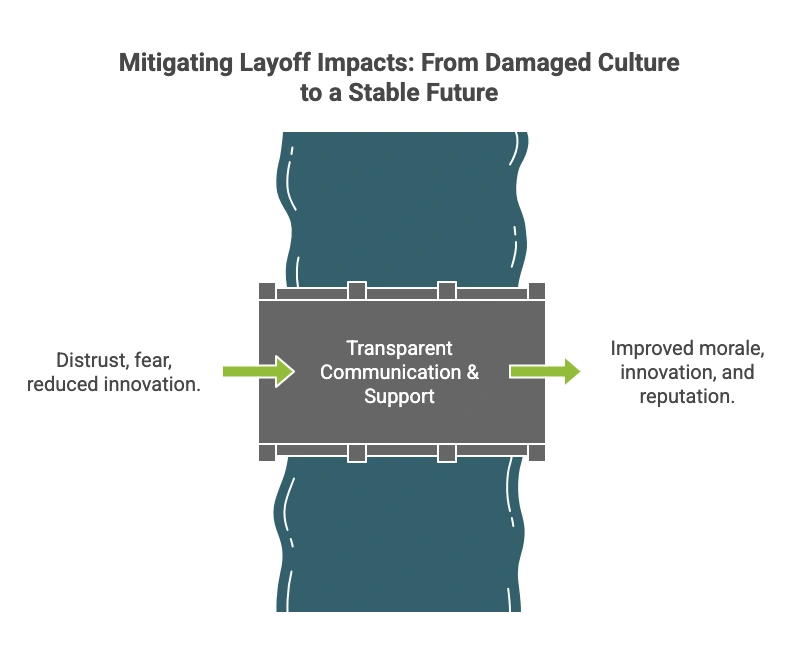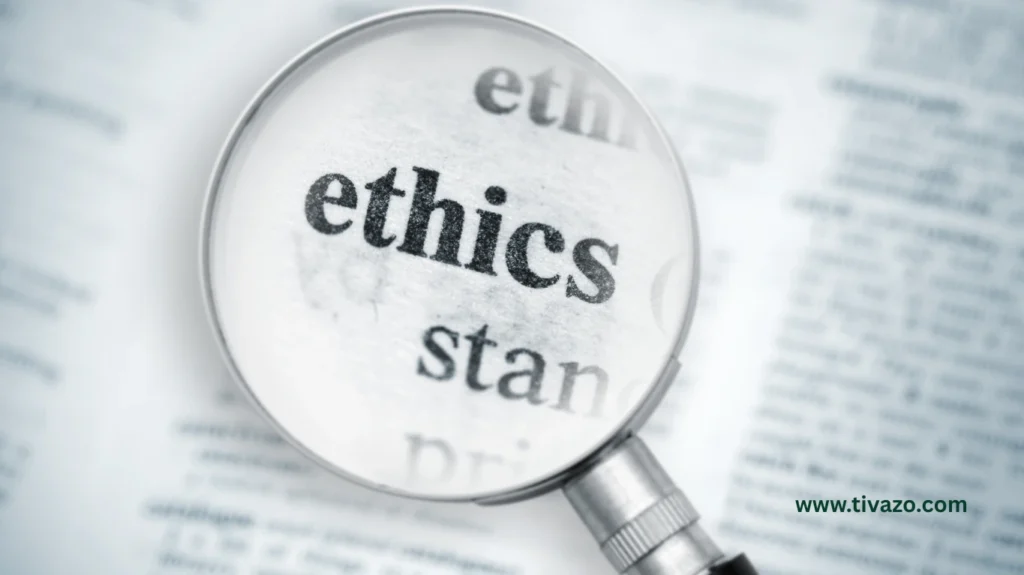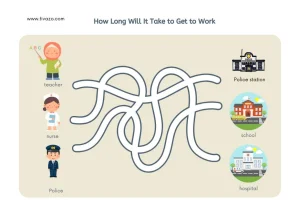Layoffs aren’t just numbers. They’re shockwaves. A layoff means employees are terminated without cause. Usually not because they failed, but because the business did.
Why does it happen? Budget cuts. Restructuring. Mergers. Automation. Sometimes it’s all of them.
But the damage doesn’t stop at the exit interview. The impact of a layoff extends beyond those let go. It poisons culture. It breaks trust. It slows everything down.
Layoffs reduce costs. Short term. What they do long-term is harder to see but worse to absorb. Morale tanks. Retention nosedives. Reputation suffers—culture frays. Business outcomes erode quietly, then suddenly. The true cost of a layoff isn’t measured in dollars. It’s measured in people.
Immediate organizational effects
The impact of a layoff is instant. People look over their shoulders. Eyes drop. Mouths stay shut.
Morale? Gone. Trust in leadership? Shattered. Those who remain feel punished, not lucky. They start wondering why they were kept. They wonder how long they’ll last.
Survivor’s guilt creeps in. Those feelings don’t boost output. They stall it. People move more slowly. Talk less. Share nothing. The workplace gets colder. More robotic. Nobody wants to speak first. Nobody wants to be next.
Managers try to fix it. But their words don’t land. Employees stop listening. They’re processing grief, fear, and uncertainty. Productivity slips, not because people slack off, but because people panic.
The impact of a layoff isn’t just emotional. It’s operational. Fewer ideas. Fewer decisions. Fewer risks. Work becomes cautious. Everyone’s in self-preservation mode. Trust doesn’t recover overnight. Sometimes it doesn’t recover at all.
The cultural and psychological fallout
The impact of a layoff on culture is slow, deep, and corrosive.
Psychological safety dies first. Teams stop challenging each other. They stop giving honest feedback. Meetings feel staged. Nobody takes creative risks. Collaboration declines. People stay in their lanes. They avoid making noise.

Toxicity fills the silence. Finger-pointing rises. People hoard tasks to look useful. Managers micromanage more. Internal politics spike. Everyone’s watching, calculating, and protecting themselves.
The culture that once supported innovation, autonomy, and trust now promotes caution, fear, and passive disengagement.
Absenteeism increases. Not just physically. Mentally. People clock in but aren’t present. Presenteeism climbs. Burnout follows. Culture becomes a liability, not an asset.
The impact of a layoff on culture rarely shows up in the first week. It shows up six months later. In resignations. In silence. In missed opportunities. You don’t fix it with a team lunch or a motivational email. The damage compounds.
long-term business consequences
The brand bleeds. Talent stops applying. People talk. Online reviews spike with bad stories. Candidates’ ghost interviews. The company stops being a “great place to work.”
The impact of a layoff doesn’t just sit inside the building. It leaks. And it lingers.
Institutional knowledge disappears. Veterans take undocumented know-how with them. Processes break. project stalls. Onboarding gets harder. People take longer to ramp up. Quality slips.
Innovation fades. Risk-taking vanishes. Teams avoid bold decisions. They play it safe. They underperform. Growth slows. Competition wins.
Turnover doesn’t stop with the layoff. It accelerates. Top performers exit quietly. They saw the writing on the wall. They don’t wait for round two. The best people leave before you can replace them.
The impact of a layoff keeps costing long after the severance checks are cashed. In culture, in morale, in brand, in business outcomes. The pain is real. The ripple effect is relentless.
legal and ethical considerations
Layoffs come with rules. Break them, and you don’t just lose people; you risk lawsuits. In the US, the WARN Act forces employers to notify workers 60 days before mass layoffs. Skip that; pay fines. Other countries have stricter timelines and severance requirements. Most businesses ignore this until it’s too late.

Ethics get blurry. Who gets cut? Why? Patterns emerge. Older employees go first. People of color get hit harder. Women in mid-career roles vanish. Not always intentional. Still biased. DEI goals crumble fast when layoffs start without checks.
Stakeholder capitalism talks about people. Shareholder primacy talks about profit. When a layoff hits, you find out which one your company believes in. The ethical impact of a layoff shows up in who’s protected, who’s cut, and who’s forgotten.
Leaders say it’s about survival. But survival at whose expense? A layoff done without legal review and ethical clarity causes more than reputational damage. It causes legal chaos, internal distrust, and external backlash. You can’t fix that with a press release.
Best Practices for Minimizing Harm
The announcement isn’t the hardest part. What follows is.
- Start with honesty. Don’t sugarcoat. Don’t spin. Say what’s happening, why, and what comes next. No jargon. No scripts. People know when you’re lying. Speak directly.
- Don’t disappear after. Support matters more after the cut. Offer outplacement services. Help with résumés. Give access to mental health care. Don’t just drop the box and escort them out.
- Avoid the ax approach. Gradual layoffs reduce shock. Let people exit with dignity. Give choices when possible. Voluntary separation. Reduced schedules. Internal shifts. Show you tried everything first.
- Don’t wing it. Involve HR, legal, and communications early. Review every message. Align every action. Don’t rely on templates. Tailor it to your people.
- How to manage the impact of a layoff? Prepare for the aftershock. Check in with survivors. Train managers to lead through silence. Rebuild trust deliberately. People will watch what you do next. That’s when real leadership shows up. Or it doesn’t.
Alternatives to layoffs
Layoffs shouldn’t be plan A. They’re a last move. Too many use them first.
Freeze hiring. Stop backfilling. It buys time. Nobody new joins, but nobody else leaves.
Reduce hours. Cut pay temporarily. Let teams share roles. Job sharing spreads the load instead of cutting the rope.
Offer voluntary retirements. Some will take it. Others will appreciate the option. It’s cleaner than a cold call from HR.

Look inside. Redeploy. Move talent across teams. Invest in training instead of severance. It saves money long term. Avoiding the impact of a layoff is cheaper than repairing it.
Most businesses say they tried everything. They didn’t. The options exist. They just take more work than a spreadsheet.
conclusion
A layoff is easy to authorize. Hard to undo. It saves cash fast. It kills trust faster.
The impact of a layoff doesn’t end when the people leave. It sticks. It shapes culture, warps morale, and slows everything that once worked.
Don’t think like an accountant. Think like a leader. If you want long-term resilience, protect the people who create it.
HR doesn’t just cut. HR can build. But only if they stop treating layoffs like a line item and start treating them like a last resort.
Start planning earlier. Think longer. Speak honestly. That’s not kindness. That’s competence.




